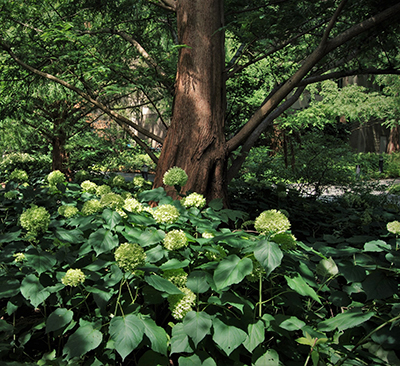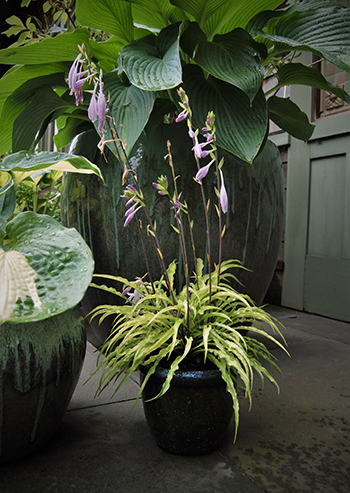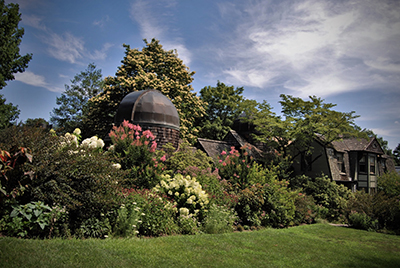
Plants of the Week: Aug 10

Hydrangea arborescens ‘Annabelle’
Hydrangea arborescens ‘Annabelle’ provides dapples of blooms along the feet of Metasequoia glyptostroboides in the Metasequoia Allee. This deciduous shrub has a loose, open habit and typically grows 3-6’ tall. The large, rounded, white, sterile flowers which sit atop gray-brown stems bloom in June for about 2 months. Dark green leaves with light green undersides wrap the stems in an opposite pattern. The leaves turn yellow in autumn providing a colorful backdrop to the muted brown seed heads which can be a wonderful addition to a dried cut flower arrangement.
This classic hydrangea is easily grown in average, moist, well-drained soils in part shade. H. arborescens, also known as smooth hydrangea, can adapt to a variety of soil conditions with the exception of dry soils where its foliage tends to significantly decline. It is native to moist or rocky wooded slopes, ravines, streambanks, and bluffs making this a great plant for rain gardens and woodland gardens. Grown in zones 3-9, a more harsh winter may cause H. arborescens ‘Annabelle’ to die back to the ground. This is not a concern however, because the blooms are produced on new wood each season. Like many hydrangea species, H. arborescens ‘Annabelle’ is susceptible to bud blight, bacterial wilt, leaf spot, mold, rust, and powdery mildew. Also, watch out for aphids, mites, scale, and nematodes. Pruning the stems to the ground in late winter results in stem vigor and larger blooms, which helps combat pests and diseases. Photo credit: R. Armstrong

Hosta ‘Curly Fries’
My excitement when finding curly fries on a menu is comparable to my excitement when finding Hosta ‘Curly Fries’ in a garden. Hostas are an especially popular perennial because of their versatility in a landscape. A seedling from the usually sterile Hosta ‘Pineapple Upsidedown Cake’, the adorable, petit, mounded habit of ‘Curly Fries’ is a perfect choice for containers. This aptly named hosta can be found in a small container next to the side entrance to the Wister Center, surrounded by larger leafed blue hosta varieties.
A 2016 Hosta of the Year, this herbaceous perennial grows best in moist, well-drained soils with an acidic to neutral pH. While most hostas are grown for their large leaves, this little arching, wiggly clump is best planted where its small characteristics can be viewed easily.
Incorporating ‘Curly Fries’ into a miniature plant collection or into the front of a perennial border will showcase its color and form. Also known as plantain lilies, the unique pop of color from Hosta ‘Curly Fries’ exhibits best with morning sun exposure and afternoon shade. The stiff, narrow leaves are heavily ruffled, emerging chartreuse, eventually brightening to yellow. Considered a miniature, Hosta ‘Curly Fries’ matures to 6 inches tall by 16 inches wide, developing red speckles on the petioles and lavender flowers atop the clump in midsummer. Photo credit: R. Armstrong

Poliothyrsis sinensis
Seemingly perched atop the old observatory at the Cunningham House is Poliothyrsis sinensis, more commonly known as a pearl-bloom tree. Flowering from August to September, this showy, fragrant tree compliments the blooming hydrangeas and crapemyrtles at its forefront. P. sinensis are best grown in rich to medium moist, well-draining soils and become drought tolerant once established. Grown in full sun to part shade, this tree will reach a mature height of 30-40’ and spread to 15-25’. Pearl-bloom tree is hardy to USDA Zones 6-7 but may survive winters in Zone 5 if sited in a protected spot.
Poliothyrsis sinensis is the sole species within the genus Poliothyrsis. It was first discovered growing in China in the late 1800’s and was eventually brought to the Arnold Arboretum in 1908. As part of the family Salicaceae, P. sinensis has simple, smooth-margined, heart shaped leaves that can grow 7” long. In spring they emerge burgundy-bronze, eventually maturing to emerald green, and finally turning yellow in fall. Particularly noted for its fragrant, late summer flowering period, the tiny, white-aging-to-creamy-buff flowers bloom on branched conical panicles to 8” long at the tips of new stems. The flower buds only open very slightly retaining a rounded pearl-shape appearance described by the common name of pearl-bloom. P. sinensis should be sited where the flowers can be easily seen and sniffed. Flowers are monoecious, requiring no more than one plant to produce capsules containing multiple seeds. Photo credit: R. Armstrong





No Comments